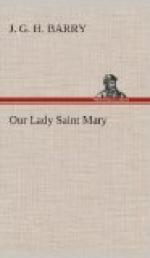With the accession of Edward VI. the Protestant element in the Reformation gained increased influence. Our question is, Did it succeed in imprinting a new theory of the nature and authority of the Church on the formal and authoritative utterances of the Church in England? The first “Act of Uniformity” of 1549 contains the now familiar appeal to Scripture and to the primitive Church, and the Book set forth is called “The Book of Common Prayer and Administration of the Sacraments, and other Rites and Ceremonies of the Church, after the Use of the Church of England.” The “Second Act of Uniformity,” 1552, uses the same language about the Church of England and the primitive Church. Passing on to the reign of Elizabeth, in the “Injunctions” of 1559 there is set forth “a form of bidding the prayers,” which begins: “Ye shall pray for Christ’s Holy Catholic Church, that is for the whole congregation of Christian people dispersed throughout the whole world, and especially for the Church of England and Ireland.” In the “Act of Supremacy” of the same year it is provided that an opinion shall “be ordered, or adjudged to be heresy, by the authority of the canonical Scriptures, or by the first four general Councils, or any of them, or by any other general Council wherein the same was declared heresy by the express and plain words of the said canonical Scriptures.” This test of doctrine is repeated in Canon VI of the Canons of 1571. “Preachers shall ... see to it that they teach nothing in the way of a sermon ... save what is agreeable to the teaching of the Old or New Testament, and what the Catholic fathers and ancient bishops have collected from this self-same doctrine[4].”
[Footnote 4: Documents in Gee & Hardy.]
It is hardly worth while to spend much time on the Homilies. I will simply note that they continue the appeal to the primitive Church which is asserted to have been holy, godly, pure and uncorrupt; and to the “old holy fathers and most ancient learned doctors” which are quoted as authoritative against later innovations. They still speak of the Church of England as continuous with the past. I do not find that they treat the contemporary reformers as of authority or quote them as against the traditional teaching of the Church.
We will go on to one more stage, that is, to the Canons of 1604 which represent the mind of the Church of England at the time of the accession of James I. They declare that “whosoever shall hereafter affirm, That the Church of England, by law established under the King’s majesty, is not a true and an apostolical church, teaching and maintaining the doctrine of the apostles; let him be excommunicated.” (III) They appeal to the “Ancient fathers of the Church, led by the example of the apostles.” (XXXI) In treating of the use of the sign of the Cross in baptism they assert that its use follows the “rules of Scripture and the practice of the primitive Church.” And further, “This use of the sign of the Cross




